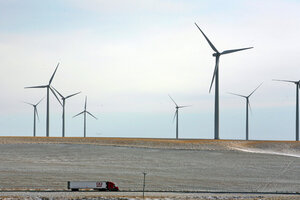Governors prod Washington on renewable energy
Anxious over lack of progress on a new energy bill, a group of 29 state governors has sent the White House and Congress a list of renewable energy recommendations, seeking support for wind and solar projects.

Governors from 29 states have sent the White House and Congress a letter urging action on a national renewable energy standard that would provide backing for projects like this one in Montana.
Melanie Stetson Freeman/The Christian Science Monitor/File
A group of 29 state governors has for the first time submitted to the White House and Congress a list of recommendations to implement renewable energy nationwide. The move reveals growing impatience with Washington's inability to put forward a new energy-climate bill to stimulate growth of solar and wind industry jobs.
With the capitol still consumed with healthcare legislation and the likelihood of a national bill that combines climate and energy dimming rapidly, many states with renewable energy in their backyards are agitating for job creation from wind, solar, and biomass energy development.
In particular, they want a national renewable electricity standard in a new energy bill. Such a standard, the governors say, should set a minimum requirement for electric utilities to get at least 10 percent of their electricity from sources like solar, wind, and biopower by 2012 – that would put them on track to reach 20 percent by 2020, a target being weighed in Congress.
IN PICTURES: The Answer is blowing in the wind
About half of states already have similar "portfolio standards," which vary widely. More uniform standards would, for instance, increase demand for wind, whose manufacturing base in the Midwest is substantial and growing, but still immature, according to the governors' report. Even if a new energy bill doesn't materialize, they still want their proposal considered and passed on its own merits.
“Congressional action on the energy bill seems to have stalled," said Rhode Island Gov. Donald Carcieri in a statement. "It is our hope that these recommendations — and the national bipartisan consensus they represent — will advance the energy deliberations now under way in Congress."
Other recommendations by the governors include:
- Building new interstate transmission lines and infrastructure to bring renewable energy from large centralized facilities sited in remote but sunny deserts or the windy plains states to US population centers in the Midwest and East Coast.
- Increasing explicit support for coastal, deep water, and offshore wind technology and transmission research and development at the Department of Energy, as well as streamlining the permitting process for locating wind farms.
- Extending the Treasury Department's financing program that offers cash up front instead of the Investment Tax Credit, as well as a renewable energy production tax credit.
"To me what the governors are doing suggest there is real concern that any progress on climate and energy is getting snarled up in the notion of an all or nothing proposition," says Frank O'Donnell, president of Clean Air Watch, a Washington environmental group.
"They're saying we need to move ahead with something positive, rather than waiting for a magic solution that may not come."
Other energy experts agree that the governors' moves are timely. More than half the states now have renewable energy standards – none has ever repealed or reduced their level of commitment – and most have increased or even doubled it, says Reid Detchon, executive director of the Energy Future Coalition, a nonpartisan alliance of business, labor, and environmental groups.
"These governors coming forward like this is just one more indicator of public sentiment in favor of stronger requirements for renewable energy," he says. "People want more renewable energy. Congress can't ask for a clearer signal for what works politically than what's working at the state level."
